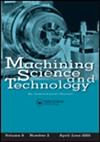金属激光直接烧结电火花加工钛合金(Ti6Al4V)电极的性能分析
IF 2.6
4区 工程技术
Q2 ENGINEERING, MANUFACTURING
引用次数: 2
摘要
摘要近年来,基于增材制造的快速工装(RT)在制造业越来越受欢迎,因为可以大大减少工具制造时间和成本。为此,对直接金属激光烧结制备的AlSi10Mg工具电极的加工性能进行了实验研究,并与常用的铜和石墨电极在钛合金工件的电火花加工中进行了比较。分析了电火花加工参数对材料去除率、刀具磨损率、算术平均表面粗糙度、表面裂纹密度、白层厚度和显微硬度等性能指标的影响。通过扫描电子显微镜检查使用不同电极产生的加工表面,以研究表面完整性。观察到,在较低的加工参数设置下,使用AlSi10Mg DMLS电极可以获得优异的表面完整性。能量色散X射线光谱分析表明,工具电极元件转移到加工表面上是随着加工表面上碳和氧百分比的增加而发生的。通过X射线衍射分析发现,在加工表面形成了碳化钛和碳化钒等金属碳化物,从而提高了表面的显微硬度。本文章由计算机程序翻译,如有差异,请以英文原文为准。
Performance analysis of EDM electrode manufactured by direct metal laser sintering during machining of titanium alloy (Ti6Al4V)
Abstract Recently, additive manufacturing based rapid tooling (RT) is gaining popularity in manufacturing industries because tool fabrication time and cost can be substantially reduced. In this regard, an experimental investigation is made to explore the machining performance of AlSi10Mg tool electrode manufactured through direct metal laser sintering and compared with commonly used copper and graphite electrodes in electro-discharge machining (EDM) of titanium alloy work piece. The influence of EDM variables on performance measures like material removal rate, tool wear rate, arithmetic mean surface roughness, surface crack density, white layer thickness and microhardness has been analyzed. The machined surface generated with the usage of different electrodes is inspected by scanning electron microscopy to study the surface integrity. It is observed that superior surface integrity can be attained utilizing AlSi10Mg DMLS electrode at lower setting of machining parameters. Energy dispersion X-ray spectroscopy analysis reveals that transfer of tool electrode elements onto the machined surface occurs along with increase in percentage of carbon and oxygen on the machined surface. From the X-ray diffraction analysis, it is found that metal carbides like titanium carbide and vanadium carbide are formed on the machined surface leading to increase in microhardness of the surface.
求助全文
通过发布文献求助,成功后即可免费获取论文全文。
去求助
来源期刊

Machining Science and Technology
工程技术-材料科学:综合
CiteScore
5.70
自引率
3.70%
发文量
18
审稿时长
6 months
期刊介绍:
Machining Science and Technology publishes original scientific and technical papers and review articles on topics related to traditional and nontraditional machining processes performed on all materials—metals and advanced alloys, polymers, ceramics, composites, and biomaterials.
Topics covered include:
-machining performance of all materials, including lightweight materials-
coated and special cutting tools: design and machining performance evaluation-
predictive models for machining performance and optimization, including machining dynamics-
measurement and analysis of machined surfaces-
sustainable machining: dry, near-dry, or Minimum Quantity Lubrication (MQL) and cryogenic machining processes
precision and micro/nano machining-
design and implementation of in-process sensors for monitoring and control of machining performance-
surface integrity in machining processes, including detection and characterization of machining damage-
new and advanced abrasive machining processes: design and performance analysis-
cutting fluids and special coolants/lubricants-
nontraditional and hybrid machining processes, including EDM, ECM, laser and plasma-assisted machining, waterjet and abrasive waterjet machining
 求助内容:
求助内容: 应助结果提醒方式:
应助结果提醒方式:


